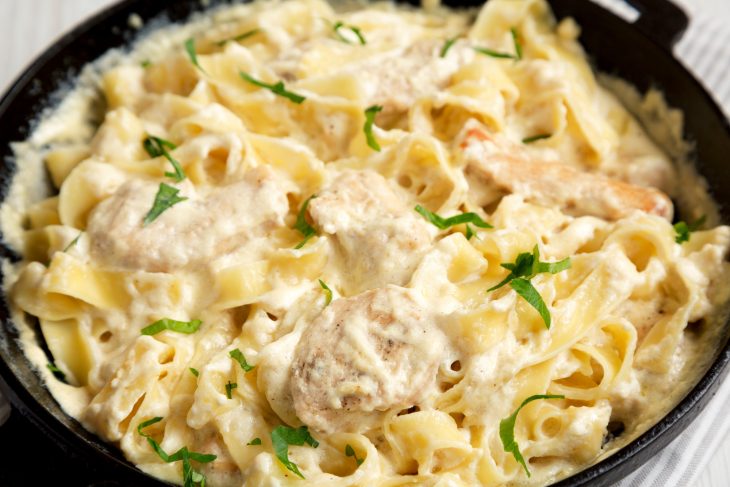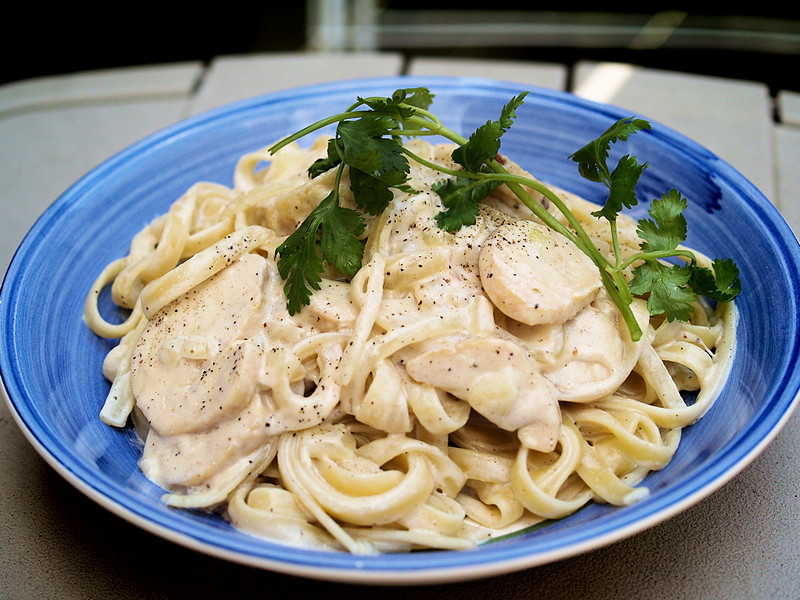
Chicken Alfredo is a classic Italian-inspired dish loved by many for its creamy texture and flavorful combination of chicken, pasta, and a rich Alfredo sauce. While it may be considered indulgent and comforting, it’s important to understand the nutritional aspects of Chicken Alfredo to make informed choices about its consumption. In this article, we will explore the nutrition facts of Chicken Alfredo, shedding light on its calorie content, macronutrient composition, and key vitamins and minerals. So, let’s dive into the world of Chicken Alfredo and discover how it fits into a balanced diet.
What is Chicken Alfredo?
Chicken Alfredo is a pasta dish that originated in Italy and has become immensely popular worldwide. The classic preparation typically involves fettuccine pasta, grilled or sautéed chicken breast, and a creamy Alfredo sauce. The sauce is a luscious blend of butter, heavy cream, and Parmesan cheese, seasoned with garlic, salt, and pepper. The combination of tender chicken and velvety sauce makes Chicken Alfredo a delightful and satisfying culinary experience.
Calories and Portion Sizes
When considering the nutrition facts of Chicken Alfredo, it’s crucial to understand the caloric content and portion sizes. The calorie count can vary depending on the recipe and ingredients used. However, on average, a serving size of Chicken Alfredo with 4 ounces of cooked chicken breast, 1 cup of cooked pasta, and ½ cup of Alfredo sauce can provide approximately 600-800 calories.
Carbohydrates
A serving of Chicken Alfredo can contain around 60-80 grams of carbohydrates, primarily from the pasta used in the dish. Carbohydrates provide the body with energy and are an essential part of a balanced diet.

Proteins
Chicken is a significant source of protein in Chicken Alfredo. A typical serving may contain approximately 30-40 grams of protein, which plays a crucial role in muscle maintenance and repair.
Fats
The creamy Alfredo sauce contributes to the fat content in Chicken Alfredo. A serving can contain around 30-40 grams of fat, with most of it coming from the sauce. It’s important to note that fat is a concentrated source of energy and should be consumed in moderation as part of a balanced diet.
Saturated Fats
The saturated fat content is quite high, around 15 to 20 grams per serving, mainly due to the presence of butter and cream.
Sodium
Chicken Alfredo tends to be on the higher side of sodium content, with approximately 800 to 1000 milligrams per serving. The sauce, cheese, and seasoning add to the overall sodium levels.
Calcium
The Alfredo sauce in Chicken Alfredo typically contains Parmesan cheese, which is a good source of calcium. Calcium is essential for strong bones and teeth.
Vitamin B12
Chicken is a natural source of vitamin B12, a nutrient important for red blood cell production and nerve function.
Vitamin A
The use of butter or heavy cream in the Alfredo sauce contributes to the vitamin A content of Chicken Alfredo. Vitamin A is essential for healthy vision and immune function.
Balance Your Plate
Combine a serving of Chicken Alfredo with a variety of vegetables and a side of whole grain bread to create a balanced plate that includes carbohydrates, protein, fats, and fiber.
Control Portion Sizes
Opt for a smaller portion of Chicken Alfredo and fill the rest of your plate with nutrient-rich vegetables. This way, you can satisfy your cravings while managing your calorie intake.
Occasional Treat
Enjoy Chicken Alfredo as an occasional treat or special indulgence rather than a regular part of your diet. This way, you can appreciate its flavors while still maintaining a healthy eating pattern.

Conclusion
Chicken Alfredo is a delectable pasta dish loved by many. While it is important to enjoy food, understanding its nutrition facts helps make informed choices. Chicken Alfredo can be part of a balanced diet when consumed in moderation and with mindful ingredient choices. By considering portion sizes, macronutrient breakdown, and the inclusion of essential vitamins and minerals, you can savor this creamy delight while maintaining a nutritious eating plan.
Frequently Asked Questions (FAQs)
Is Chicken Alfredo high in calories?
Yes, Chicken Alfredo is relatively high in calories due to the combination of pasta, chicken, and the creamy Alfredo sauce. It is important to be mindful of portion sizes when consuming Chicken Alfredo.
Can I make Chicken Alfredo healthier?
Yes, you can make Chicken Alfredo healthier by making simple substitutions and additions. Use whole wheat pasta, opt for a lighter version of the sauce using low-fat milk or Greek yogurt, and incorporate vegetables to increase the nutritional value.
What are the main macronutrients in Chicken Alfredo?
The main macronutrients in Chicken Alfredo are carbohydrates from the pasta, proteins from the chicken, and fats from the Alfredo sauce.
Can Chicken Alfredo provide essential vitamins and minerals?
Yes, Chicken Alfredo can provide essential vitamins and minerals. The Alfredo sauce may contain calcium from Parmesan cheese, chicken contributes vitamin B12, and the use of butter or cream adds vitamin A.
Can Chicken Alfredo be part of a balanced diet?
Yes, Chicken Alfredo can be part of a balanced diet when consumed in moderation and with mindful ingredient choices. Be aware of portion sizes and consider incorporating healthier alternatives to reduce the calorie and fat content.
Was this page helpful?
Our commitment to delivering trustworthy and engaging content is at the heart of what we do. Each fact on our site is contributed by real users like you, bringing a wealth of diverse insights and information. To ensure the highest standards of accuracy and reliability, our dedicated editors meticulously review each submission. This process guarantees that the facts we share are not only fascinating but also credible. Trust in our commitment to quality and authenticity as you explore and learn with us.


